Papers by Gwilherm NENERT
Dalton Trans., 2015
We have reinvestigated the crystal structure of the low-dimensional fluoride β-FeF3(H2O)2·H2O usi... more We have reinvestigated the crystal structure of the low-dimensional fluoride β-FeF3(H2O)2·H2O using high resolution neutron and X-ray diffraction data.

Acta Crystallographica Section A Foundations of Crystallography
Polycrystalline mullite-type PbMBO 4 (M = Al, Ga, Fe and Mn) samples were produced using the glyc... more Polycrystalline mullite-type PbMBO 4 (M = Al, Ga, Fe and Mn) samples were produced using the glycerin method . The lattice thermal expansion of the materials was studied by temperature-dependent X-ray powder diffraction data Rietveld refinements. The crystal structure was refined in the space group Pnam following mullite-type standardized setting [2]; therefore, the edge-sharing MO 6 octahedral chains run parallel to the crystallographic c-axis. The lattice parameters in the cooling cycles exhibit corresponding smaller values than those in the heating cycles. The onset temperature of the deviation differs due to chemical composition of the sample. The consecutive second heating did not show this effect. This irreversible alternation causes to happen due to healing of the intrinsic defects at higher temperatures. The thermal expansion of the lattice parameters is non-linear and highly anisotropic. In PbAlBO 4 , PbGaBO 4 , and PbFeBO 4 the aparameter first follows a slow decline followed by a steep contraction at higher temperatures. A converse trend was observed in PbMnBO 4 , that is, rapid contraction follows a slower one. The coefficients of thermal expansion (CTE) α(a), α(b), α(c) and α(v) were calculated for, a, b, c and cell volume, respectively, using higher order polynomial fit. Beside the investigated temperature range, the CTE was studied between 0 K and 1200 K. The proposed CTE's at low temperatures must exclude any possibility of magneto-volume effect, in particular for PbMnBO 4 and PbFeBO 4 . Because, the former one shows ferromagnetism at T c = 125 K, and the latter one antiferromagnetism at T N = 31 K [3]. The b-and c-parameters and cell volume show positive, and a negative CTE at any given temperature. The anisotropy factor (A) depends on the M-cations in the MO 6 octahedra of the sample. PbMnBO 4 shows the maximum A at 400 K, while the other phases a nonlinear increase over the temperature range. The thermal anisotropy between a and b can be explained in terms of the mechanical model of the 'Nuremberg scissors' [4] within the ab plane. This structural property sheds light to the expansion/contraction behavior of the mullite-type PbMBO 4 materials with respect to applied pressure. The onset of α → β phase transition for PbAlBO 4 was observed at about 1035 K in a separate temperature dependent X-ray diffraction experiment. The reconstructive phase transition follows a slow transformation and Avrami-type kinetics .
Acta Crystallographica Section A Foundations of Crystallography
We have investigated the crystal and magnetic structures of the trigonal iron-boracite Fe3B7O13X ... more We have investigated the crystal and magnetic structures of the trigonal iron-boracite Fe3B7O13X with X = OH by neutron diffraction. Neutron diffraction enables us to locate the hydrogen atom of the hydroxyl group and determine the magnetic ground state of this member of the multiferroic boracite family. No evidence was found for a monoclinic distortion in the magnetic ordered state. The magnetic symmetry allows for magnetoelectric and ferroelectric properties. The N/'eel tempera- ture TN of 4.86(4) K confi?rms the general trends within the boracites that TN decreases from X = I > Br > Cl > OH. Surprisingly while Fe3B7O13OH exhibits the largest frustration with |theta/?=TN| = 5.6 within the Fe3B7O13X series, no reduction of the magnetic moment is found using neutron diffraction.
UCoGe is an archetype of coexisting weak itinerant 5f -electron ferromagnetism (TC ∼ 3 K, µs = 0.... more UCoGe is an archetype of coexisting weak itinerant 5f -electron ferromagnetism (TC ∼ 3 K, µs = 0.03µB/f.u.) and superconductivity (TSC ∼ 0.6 K) at ambient pressure. The Ru substitution for Co leads to an initial sharp increase of the TC up to the maximum of TC = 8.5 K for x = 0.12, increase of spontaneous magnetic moment and suppression of superconductivity. We have grown the UCo0.88Ru0.12Ge single crystal and studied magnetization along the principal crystallographic axes. To see the microscopic background of these ndings we performed a polarized neutron diraction experiment on D3 diractometer in ILL. We have found that the Co and U moments are parallel in UCo0.88Ru0.12Ge, in contrast to the antiparallel conguration in UCoGe. This is probably the reason of the spontaneous magnetization increase with Ru doping.
Acta Physica Polonica Series a

Zeitschrift Fur Kristallographie, 2013
We report on the structural characterization of the mullite-type PbAl 1-x Mn x BO 4 series using ... more We report on the structural characterization of the mullite-type PbAl 1-x Mn x BO 4 series using neutron, synchrotron and in-house X-ray powder diffraction, Raman spectroscopy and density functional theory (DFT) calculations. The planar geometry of the BO 3 group changes only slightly over the whole composition range. The rigid BO 3 group plays the dominant roles in the thermal contraction in the a-direction followed by expansion in the b-and c-directions, leading to a correlation a Á b/c $ unity. The unit-cell volume at zero-pressure and 0 K was obtained, as well evaluated as the isothermal bulk-modulus from pressure dependent synchrotron X-ray diffraction using a diamond anvil cell as well as DFT calculations. Thermal expansion of the metric parameters was modeled using a first-order Grüneisen approximation for the zero-pressure equation of state. We used the double-Debye-double-Einstein-Anharmonicity model to calculate the temperaturedependent internal energy of the crystalline end members. The simulation helped to understand the anisotropic thermal expansion and together with the experimental and calculated bulk moduli to approximate the thermodynamic Grüneisen parameters.

Journal of Physics: Conference Series, 2014
ABSTRACT We report on the performance of the first diamond neutron monochromator built at the ILL... more ABSTRACT We report on the performance of the first diamond neutron monochromator built at the ILL. It has been designed for the hot neutron diffractometer D9 with the aim of improving significantly the instrument performance in particular for short wavelengths in the 0.3-0.9 Å wavelength range. Diamond crystal plates with dimensions of 1.5 x 1.5 x 0.18 cm3 an average mosaic spread of 0.15° have been synthesized at the University of Augsburg. They exhibited excellent neutron diffraction properties when examined on a neutron double-crystal test setup. Sufficiently thick diamond elements with a controlled mosaic spread of 0.25° have been obtained by stacking several of these crystals. First tests runs carried out at the ILL confirmed the predicted high reflectivity of the diamond stacks. The diamond prototype monochromator uses the (220) reflection in transmission geometry replacing the Cu (220) monochromator on D9 that has the same d-spacing. The final performance studies on D9 showed that the diamond device did not perform better than the original copper crystal. This unexpected result could be explained by significant optical aberrations caused by non- uniformities of both the angular and spatial mosaic distribution in the individual diamond crystals, as revealed by a detailed characterisation study using high-energy X-ray diffraction.
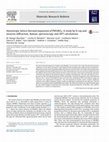
Materials Research Bulletin, 2014
The lattice thermal expansion of mullite-type PbFeBO 4 is presented in this study. The thermal ex... more The lattice thermal expansion of mullite-type PbFeBO 4 is presented in this study. The thermal expansion coefficients of the metric parameters were obtained from composite data collected from temperaturedependent neutron and X-ray powder diffraction between 10 K and 700 K. The volume thermal expansion was modeled using extended Grüneisen first-order approximation to the zero-pressure equation of state. The additive frame of the model includes harmonic, quasi-harmonic and intrinsic anharmonic potentials to describe the change of the internal energy as a function of temperature. The unit-cell volume at zeropressure and 0 K was optimized during the DFT simulations. Harmonic frequencies of the optical Raman modes at the G -point of the Brillouin zone at 0 K were also calculated by DFT, which help to assign and crosscheck the experimental frequencies. The low-temperature Raman spectra showed significant anomaly in the antiferromagnetic regions, leading to softening or hardening of some phonons. Selected modes were analyzed using a modified Klemens model. The shift of the frequencies and the broadening of the line-widths helped to understand the anharmonic vibrational behaviors of the PbO 4 , FeO 6 and BO 3 polyhedra as a function of temperature.
ChemInform, 2013
ABSTRACT The thermal expansion of the title compound (space group Pbam) is investigated by single... more ABSTRACT The thermal expansion of the title compound (space group Pbam) is investigated by single crystal neutron diffraction at 298 and 900 K and powder XRD over the range 298—1173 K.

Zeitschrift für Kristallographie - Crystalline Materials, 2000
ABSTRACT Large crystals of Bi2M4O9 (M = Fe, Ga) were examined by single-crystal neutron diffracti... more ABSTRACT Large crystals of Bi2M4O9 (M = Fe, Ga) were examined by single-crystal neutron diffraction at the Institut Laue Langevin (ILL) in Grenoble. The crystal structures of these bismuth metal oxides are commonly described as mullite-type compounds in space group Pbam. However, up to several hundreds of reflections were observed in both compounds with significant intensity violating the reflection conditions in this space group. Psi-scans with a short wavelength (0.837 Å at D9) were quasi-continuous and thus provided ambiguous results, hampering the identification of the source of these intensities. With a much longer wavelength (2.364 Å at D10) the Psi scans displayed strong variations of the intensities with small changes of the scan angle Psi. These Psi scan intensities could be well matched by an appropriate calculation with the program UMWEG (Rossmanith, 2003) and thus multiple diffraction turned out to be the source of these extra reflections. As a result the space group Pbam proved to be the correct one. Due to widespread misconceptions the geometrical background of Umweganregung is discussed to considerable detail.
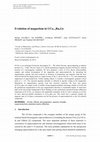
Proceedings of the International Conference on Strongly Correlated Electron Systems (SCES2013), 2014
UCoGe is an archetypal 5f-electron ferromagnet (T C ~ 3K) which becomes superconducting at ambien... more UCoGe is an archetypal 5f-electron ferromagnet (T C ~ 3K) which becomes superconducting at ambient pressure (T SC ~ 0.6K). The low values of T C and the spontaneous magnetic moment of 0.03μ B /f.u. indicate nearness of a ferromagnetic instability. We have prepared a series of UCo 1-x Ru x Ge polycrystalline samples and studied development of the magnetism and superconductivity by measuring the magnetization, specific heat and resistivity as functions of temperature and magnetic field. We have observed that the Ru doping leads to a rapid increase of the T C up to 8.5K for x = 0.1 and simultaneous suppression of superconductivity. Further doping reduces T C towards a ferromagnetic quantum critical point at x ≈ 0.3. The expected quantum criticality is reflected in specific scaling in the temperature dependence of magnetization, specific heat and electrical resistivity. We have also grown an UCo 0.88 Ru 0.12 Ge single crystal. It exhibits strong magnetocrystalline anisotropy similar to UCoGe but the spontaneous magnetization in the easy magnetization direction is considerably higher. To shed more light on the microscopic background of these findings we have performed a polarized neutron diffraction experiment at D3 in ILL. In contrast to the antiparallel orientation of the Co and U moments in UCoGe we have observed parallel orientation in UCo 0.88 Ru 0.12 Ge. This result rises a question whether the magnetic state of Co plays a momentous role for the presence of superconductivity in the U(Co,Ru)Ge compounds.
Physics and Chemistry of Minerals, 2013
ABSTRACT
Zeitschrift für Kristallographie - New Crystal Structures, 2012
PbMn 0.5 Al 0.5 BO 4 ,o rthorhombic, Pnam (no. 62), a =6.88207(22) Å, b =8.26813(31) Å, c =5.8476... more PbMn 0.5 Al 0.5 BO 4 ,o rthorhombic, Pnam (no. 62), a =6.88207(22) Å, b =8.26813(31) Å, c =5.84767(20) Å, V =332.74 Å 3 , Z =1,R p =0 .0381(i),0 .0458(ii), 0.0505(iii), R wp =0.0491(i), 0.0676(ii), 0.0677(iii), T =298 K.

Microporous and Mesoporous Materials, 2014
ABSTRACT The crystal structure of a natural davyne [(Na3.98K1.79Ca1.89Mg0.02Fe0.01)∑7.69(Al5.99Si... more ABSTRACT The crystal structure of a natural davyne [(Na3.98K1.79Ca1.89Mg0.02Fe0.01)∑7.69(Al5.99Si6.01O24)(SO4)0.65Cl1.96, a = 12.7908(5) Å, c = 5.3469(2) Å and V = 757.59(6) Å3, space group P63], its thermoelastic behaviour and low-temperature induced structural evolution have been investigated by single-crystal neutron diffraction and in situ single-crystal X-ray diffraction within the range 110 ⩽ T (K) ⩽ 293. X-ray and neutron structure refinements provided a better picture of the disordered configuration of the SO4-groups and of the cation sites into the [0 0 0 1]-channel. No evidence of phase transition or change of the thermoelastic behavior have been observed within the T-range investigated. The volume thermal expansion coefficient is αV = 4.2(4)∗10−5 K−1, and the axial thermal coefficients are αa = 1.4(1)∗10−5 K−1 and αc = 1.6(1)∗10−5 K−1. A series of structure refinements based on X-ray intensity data collected between 293 and 110 K showed that the structural evolution of davyne is driven by the rotation of the rigid TO4 framework tetrahedra. The main deformation mechanisms of framework and extraframework population, in response to the applied temperature, are described. A comparison between the low-temperature structure evolution of the isotypic davyne, balliranoite and cancrinite is carried out.
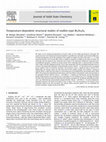
Journal of Solid State Chemistry, 2013
We report on the temperature-dependent structural studies on the mullite-type Bi 2 Fe 4 O 9 compo... more We report on the temperature-dependent structural studies on the mullite-type Bi 2 Fe 4 O 9 compound. The crystal structures were determined using both powder X-ray diffraction and single crystal neutron diffraction. The thermal expansion of the cell parameters from smallest to largest occurred in the order aocob; their expansion behavior was fit using either linear or nonlinear regression according to the region of choice. The anisotropic thermal expansion was monitored with respect to the expansion coefficients, anisotropy factor, and polyhedral geometry. At 900 K an abrupt change of the anisotropy factor is observed which correlates with a slope in the BiO 6 polyhedral volume. At the same temperature the FeO 4 tetrahedral distortion starts to increase. The temperature-dependent stereochemically activity of the Bi 3 þ 6s 2 lone electron pair was probed by the absolute value of eccentricity parameter. This parameter shows a significant drop at around 773 K. Additionally, the average crystal size and micro-strain of the powder samples were studied. A healing of intrinsic defects is observed with respect to a decreasing micro-strain followed by crystal growth above about 900 K. The temperature-dependent infrared spectra were described in three distinct zones. Deconvolution of the absorption features between 370 cm À 1 and 1000 cm À 1 required nine fitted bands, and the decomposed Pseudo-Voigt elements were assigned to Fe-O stretching, Fe-O-Fe bending and O-Fe-O bending vibrations. The shift of the observed modes was described with respect to temperature. An effective linewidth parameter Dcorr was determined by autocorrelation analysis between 740 cm À 1 and 900 cm À 1 for each temperaturedependent spectrum. The break of the slope of Dcorr at about 773 K was interpreted as the change of some vibrational modes of the FeO 4 tetrahedra. The intrinsic effects observed around 773 K are responsible for extrinsic parameter changes found around 900 K.
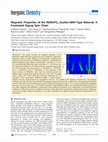
Inorganic Chemistry, 2013
The crystal structure and magnetic properties of the RbMnPO 4 zeolite-ABW-type material have been... more The crystal structure and magnetic properties of the RbMnPO 4 zeolite-ABW-type material have been studied by temperaturedependent neutron powder diffraction, low-temperature magnetometry, and heat capacity measurements. RbMnPO 4 represents a rare example of a weak ferromagnetic polar material, containing Mn 2+ ions with T N = 4.7 K. The neutron powder diffraction pattern recorded at T = 10 K shows that the compound crystallizes in the chiral and polar monoclinic space group P2 1 (No. 4) with the unit cell parameters: a = 8.94635(9), b = 5.43415(5), and c = 9.10250(8) Å and β = 90.4209(6)°. A close inspection of the crystal structure of RbMnPO 4 shows that this material presents two different types of zigzag chains running along the b axis. This is a unique feature among the zeolite-ABW-type materials exhibiting the P2 1 symmetry. At low temperature, RbMnPO 4 exhibits a canted antiferromagnetic structure characterized by the propagation vector k 1 = 0, resulting in the magnetic symmetry P2 1 ′. The magnetic moments lie mostly along the b axis with the ferromagnetic component being in the ac plane. Due to the geometrical frustration present in this system, an intermediate phase appears within the temperature range 4.7−5.1 K characterized by the propagation vector k 2 = (k x , 0, k z ) with k x /k z ≈ 2. This ratio is reminiscent of the multiferroic phase of the orthorhombic RMnO 3 phases (R = rare earth), suggesting that RbMnPO 4 could present some multiferroic properties at low temperature. Our density functional calculations confirm the presence of magnetic frustration, which explains this intermediate incommensurate phase. Taking into account the strongest magnetic interactions, we are able to reproduce the magnetic structure observed experimentally at low temperature. | Inorg. Chem. 2013, 52, 9627−9635 U = 0 eV U = 2 eV J 1 −0.74 −0.41

American Mineralogist, 2013
ABSTRACT The crystal chemistry of eosphorite from Chamachhu (Skardu District, Baltistan, Pakistan... more ABSTRACT The crystal chemistry of eosphorite from Chamachhu (Skardu District, Baltistan, Pakistan) [(Mn2+0.94Fe2+0.06Al0.01)Σ1.01AlPO4(OH1.90F0.10)Σ2·H2O, a = 6.9263(4), b = 10.4356(8), c = 13.5234(10) Å, V = 977.5(1) Å3, space group Cmca, Z = 8], has been reinvestigated by means of electron microprobe analysis in wavelength-dispersive mode and single-crystal neutron diffraction at 20 K. The anisotropic structural refinement has been performed with final agreement index R1 = 0.0381 for 82 refined parameters and 860 unique reflections with Fo > 4σ(Fo). The analysis of the difference-Fourier maps of the nuclear density allowed an unambiguous location of the H sites, the description of the H2O molecule and the OH-group configuration, along with the hydrogen-bonding scheme. We can now describe the structure of eosphorite as built by (Mn,Fe)O4(OH,H2O)2 and AlO2(OH)2(OH,H2O)2 octahedra, which both form chains running along [100]. The two types of chains are connected, via shared corners, to form a set of (100) sheets held together by P-tetrahedra (and hydrogen bonds) to form a three-dimensional framework. This material provides the rare opportunity to investigate the H-bond configuration of coexisting hydroxyl groups and H2O molecules in minerals by single-crystal neutron diffraction

Inorganic Chemistry, 2012
The structures of the doubly ordered perovskites NaCeMnWO(6) and NaPrMnWO(6), with rock salt orde... more The structures of the doubly ordered perovskites NaCeMnWO(6) and NaPrMnWO(6), with rock salt ordering of the Mn(2+) and W(6+)B-site cations and layered ordering of the Na(+) and (Ce(3+)/Pr(3+)) A-site cations, have been studied by transmission electron microscopy, electron diffraction, neutron and synchrotron X-ray powder diffraction. Both compounds possess incommensurately modulated crystal structures. In NaCeMnWO(6) the modulation vector (with reference to the ideal ABX(3) perovskite subcell) is q ≈ 0.067a* (∼58.7 Å) and in NaPrMnWO(6)q ≈ 0.046a* (∼85.3 Å). In both compounds the superstructures are primarily the two-dimensional chessboard type, although some crystals of NaCeMnWO(6) were found with one-dimensional stripes. In some crystals of NaPrMnWO(6) there is a coexistence of chessboards and stripes. Modeling of neutron diffraction data shows that octahedral tilting plays an important role in the structural modulation.
American Mineralogist, 2009
ABSTRACT







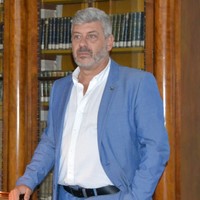



Uploads
Papers by Gwilherm NENERT